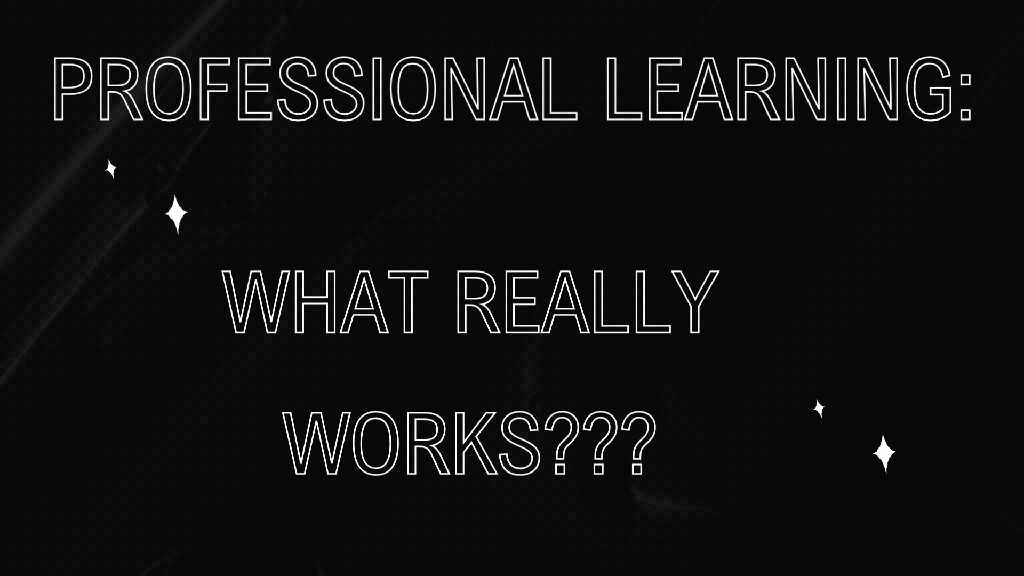
Professional Learning
Teachers are given a lot of information in workshops, but they are not given the time or support to apply that information in their classrooms. This leads to PD that is quickly forgotten and has little impact on student learning. Kristin Daniel identifies with the low-tech teacher type. She was very nervous about using technology and needed a lot of support to learn how to use it effectively. Kristin’s colleagues at her organization are a mix of all three types of teachers. Some are low-tech, some are average technology users, and some are highflyers. Kristin’s PL dollars are being spent on workshops and conferences.
The 5 principles of PL are:
🌟Focus on student learning: PD should be focused on improving student outcomes.
🌟Be collaborative: PD should be a collaborative process that involves teachers working together.
🌟 Be job-embedded: PD should be integrated into teachers’ daily work.
🌟 Be sustained: PD should be an ongoing process, not a one-time event.
🌟 Be personalized: PD should be tailored to the individual needs of teachers.
If effectively implemented, the 5 principles of PL will make a difference by ensuring that PD is relevant, meaningful, and sustainable. It will also help to build a culture of collaboration and innovation among teachers.
The duration factor is important for effective learning. PD should be ongoing and not a one-time event. Teachers need time to experiment with new ideas and reflect on their practice.
Why is Most Professional Learning(PL) So Ineffective
Most professional learning (PL) initiatives fail to be effective due to several factors, including poor alignment with teachers’ actual needs, lack of ongoing support, and insufficient time for implementation. The report “The Mirage: Confronting the Hard Truth About Our Quest for Teacher Development” highlights that despite significant investments in PL, there’s little evidence that these efforts result in substantial improvements in teaching practices or student outcomes. This disconnect arises because PL often focuses on generalized, one-size-fits-all workshops rather than personalized, continuous, and practice-focused learning experiences that resonate with teachers’ day-to-day challenges (TNTP, 2015).
If effectively implemented, how will the 5 principles of PL make a difference?
The five principles of effective PL—focused, continuous, collaborative, job-embedded, and data-driven—are designed to create a more impactful learning environment for teachers. For example, adopting a continuous approach, as opposed to one-off workshops, ensures that teachers receive ongoing support, which is critical for deep learning and sustained change in practice. Kristin Daniels highlights the importance of job-embedded learning, where teachers can immediately apply what they learn in their classrooms, thereby reinforcing new skills through practice. The duration factor is crucial; effective learning requires time, not just in terms of hours spent in training, but in the time allowed for teachers to experiment, reflect, and refine their practices.
How open is your organization to alternative approaches to development?
organization is moderately open to alternative approaches to development, particularly those that are evidence-based and have demonstrated success in other settings. However, there is still a tendency to default to traditional methods, such as workshops and seminars, which are more familiar and easier to organize on a large scale. Introducing new methods, such as peer coaching or technology-enhanced PL, often requires pilot programs and strong advocacy from within.
How can you promote this alternative form of PL to your organization?
Promoting alternative forms of PL within my organization requires a strategic approach that includes demonstrating the effectiveness of these methods through data and case studies, as well as building a coalition of supportive teachers and administrators. For instance, one could advocate for more personalized and job-embedded learning by showcasing success stories from similar organizations and providing opportunities for teachers to experience these methods firsthand. Additionally, aligning these alternative approaches with the organization’s goals and priorities will be key to gaining buy-in.
We had you read a review of the Mirage report - why is this important?
Reading a review of “The Mirage” report is important because it offers critical insights and alternative perspectives on the report’s findings. Reviews can highlight potential biases, gaps in the data, or provide additional context that might not be immediately apparent. This broader understanding allows educators and administrators to make more informed decisions about PL practices and to critically assess whether their current strategies are truly effective or need to be reimagined.
Why should you be familiar with Standards for Professional Learning and their Quick Reference Guide?
Familiarity with the Standards for Professional Learning and their Quick Reference Guide is essential because these standards provide a framework for designing, implementing, and evaluating PL. They ensure that PL activities are aligned with best practices and are likely to result in meaningful improvements in teaching and learning. By adhering to these standards, educators can create a more structured and effective professional learning environment that meets the diverse needs of all teachers.
Reference
- Daniels, Kristin.“Empowering the Teacher Technophobe: Kristin Daniels at TEDxBurnsvilleED.” YouTube, 2013. https://youtu.be/puiNcIFJTCU.
- The New Teacher Project (TNTP).“The Mirage: Confronting the Hard Truth About Our Quest for Teacher Development.” TNTP, 2015. https://tntp.org/publications/view/evaluating-teaching-the-mirage.
- Standards for Professional Learning.Learning Forward. Accessed August 22, 2024. https://standards.learningforward.org.
